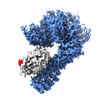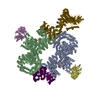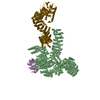[English] 日本語
 Yorodumi
Yorodumi- EMDB-19056: CryoEM structure of mTORC1 with a paediatric kidney cancer-associ... -
+ Open data
Open data
- Basic information
Basic information
| Entry |  | ||||||||||||
|---|---|---|---|---|---|---|---|---|---|---|---|---|---|
| Title | CryoEM structure of mTORC1 with a paediatric kidney cancer-associated 1455-EWED-1458 duplication in mTOR, Focused region of mTOR and RAPTOR on one protomer copy. | ||||||||||||
 Map data Map data | Focussed cryoEM map of mTORC1 with a paediatric kidney cancer-associated 1455-EWED-1458 duplication in mTOR. Focused on mTOR and RAPTOR region of one protomer. | ||||||||||||
 Sample Sample |
| ||||||||||||
 Keywords Keywords | Target of Rapamycin / mTOR / Cancer-associated mutants / SIGNALING PROTEIN | ||||||||||||
| Function / homology |  Function and homology information Function and homology informationRNA polymerase III type 2 promoter sequence-specific DNA binding / RNA polymerase III type 1 promoter sequence-specific DNA binding / positive regulation of cytoplasmic translational initiation / regulation of locomotor rhythm / Activation of the mRNA upon binding of the cap-binding complex and eIFs, and subsequent binding to 43S / T-helper 1 cell lineage commitment / positive regulation of pentose-phosphate shunt / positive regulation of wound healing, spreading of epidermal cells / eukaryotic initiation factor 4E binding / TORC2 signaling ...RNA polymerase III type 2 promoter sequence-specific DNA binding / RNA polymerase III type 1 promoter sequence-specific DNA binding / positive regulation of cytoplasmic translational initiation / regulation of locomotor rhythm / Activation of the mRNA upon binding of the cap-binding complex and eIFs, and subsequent binding to 43S / T-helper 1 cell lineage commitment / positive regulation of pentose-phosphate shunt / positive regulation of wound healing, spreading of epidermal cells / eukaryotic initiation factor 4E binding / TORC2 signaling / TORC2 complex / regulation of membrane permeability / cellular response to leucine starvation / negative regulation of lysosome organization / heart valve morphogenesis / TFIIIC-class transcription factor complex binding / TORC1 complex / voluntary musculoskeletal movement / positive regulation of transcription of nucleolar large rRNA by RNA polymerase I / positive regulation of odontoblast differentiation / calcineurin-NFAT signaling cascade / RNA polymerase III type 3 promoter sequence-specific DNA binding / positive regulation of keratinocyte migration / regulation of osteoclast differentiation / regulation of lysosome organization / MTOR signalling / cellular response to nutrient / cellular response to L-leucine / energy reserve metabolic process / Amino acids regulate mTORC1 / regulation of autophagosome assembly / Energy dependent regulation of mTOR by LKB1-AMPK / TORC1 signaling / serine/threonine protein kinase complex / ruffle organization / cellular response to methionine / positive regulation of osteoclast differentiation / negative regulation of cell size / positive regulation of ubiquitin-dependent protein catabolic process / cellular response to osmotic stress / negative regulation of protein localization to nucleus / anoikis / inositol hexakisphosphate binding / cardiac muscle cell development / negative regulation of calcineurin-NFAT signaling cascade / regulation of myelination / positive regulation of transcription by RNA polymerase III / negative regulation of macroautophagy / Macroautophagy / positive regulation of myotube differentiation / regulation of cell size / Constitutive Signaling by AKT1 E17K in Cancer / positive regulation of actin filament polymerization / germ cell development / TOR signaling / behavioral response to pain / mTORC1-mediated signalling / oligodendrocyte differentiation / positive regulation of oligodendrocyte differentiation / positive regulation of translational initiation / protein serine/threonine kinase inhibitor activity / social behavior / protein kinase activator activity / CD28 dependent PI3K/Akt signaling / HSF1-dependent transactivation / positive regulation of TOR signaling / regulation of macroautophagy / enzyme-substrate adaptor activity / positive regulation of G1/S transition of mitotic cell cycle / 'de novo' pyrimidine nucleobase biosynthetic process / response to amino acid / positive regulation of epithelial to mesenchymal transition / vascular endothelial cell response to laminar fluid shear stress / positive regulation of lipid biosynthetic process / heart morphogenesis / cellular response to nutrient levels / neuronal action potential / regulation of cellular response to heat / positive regulation of lamellipodium assembly / cardiac muscle contraction / T cell costimulation / phagocytic vesicle / positive regulation of stress fiber assembly / translation initiation factor binding / translation repressor activity / 14-3-3 protein binding / positive regulation of endothelial cell proliferation / negative regulation of translational initiation / cytoskeleton organization / endomembrane system / positive regulation of mitotic cell cycle / negative regulation of insulin receptor signaling pathway / negative regulation of autophagy / cellular response to amino acid starvation / positive regulation of translation / positive regulation of glycolytic process / regulation of signal transduction by p53 class mediator / cellular response to starvation / Regulation of PTEN gene transcription / VEGFR2 mediated vascular permeability Similarity search - Function | ||||||||||||
| Biological species |  Homo sapiens (human) Homo sapiens (human) | ||||||||||||
| Method | single particle reconstruction / cryo EM / Resolution: 3.1 Å | ||||||||||||
 Authors Authors | Anandapadamanaban M / Hay IM / Perisic O / Williams RL | ||||||||||||
| Funding support |  United Kingdom, European Union, 3 items United Kingdom, European Union, 3 items
| ||||||||||||
 Citation Citation |  Journal: To Be Published Journal: To Be PublishedTitle: CryoEM structure of mTORC1 with a paediatric kidney cancer-associated 1455-EWED-1458 duplication in mTOR, Focused region of mTOR and RAPTOR on one protomer copy. Authors: Anandapadamanaban M / Hay IM / Perisic O / Williams RL | ||||||||||||
| History |
|
- Structure visualization
Structure visualization
| Supplemental images |
|---|
- Downloads & links
Downloads & links
-EMDB archive
| Map data |  emd_19056.map.gz emd_19056.map.gz | 479.4 MB |  EMDB map data format EMDB map data format | |
|---|---|---|---|---|
| Header (meta data) |  emd-19056-v30.xml emd-19056-v30.xml emd-19056.xml emd-19056.xml | 23.1 KB 23.1 KB | Display Display |  EMDB header EMDB header |
| FSC (resolution estimation) |  emd_19056_fsc.xml emd_19056_fsc.xml | 18.1 KB | Display |  FSC data file FSC data file |
| Images |  emd_19056.png emd_19056.png | 127.9 KB | ||
| Masks |  emd_19056_msk_1.map emd_19056_msk_1.map | 512 MB |  Mask map Mask map | |
| Filedesc metadata |  emd-19056.cif.gz emd-19056.cif.gz | 8.8 KB | ||
| Others |  emd_19056_half_map_1.map.gz emd_19056_half_map_1.map.gz emd_19056_half_map_2.map.gz emd_19056_half_map_2.map.gz | 410.3 MB 410.3 MB | ||
| Archive directory |  http://ftp.pdbj.org/pub/emdb/structures/EMD-19056 http://ftp.pdbj.org/pub/emdb/structures/EMD-19056 ftp://ftp.pdbj.org/pub/emdb/structures/EMD-19056 ftp://ftp.pdbj.org/pub/emdb/structures/EMD-19056 | HTTPS FTP |
-Validation report
| Summary document |  emd_19056_validation.pdf.gz emd_19056_validation.pdf.gz | 1 MB | Display |  EMDB validaton report EMDB validaton report |
|---|---|---|---|---|
| Full document |  emd_19056_full_validation.pdf.gz emd_19056_full_validation.pdf.gz | 1 MB | Display | |
| Data in XML |  emd_19056_validation.xml.gz emd_19056_validation.xml.gz | 25.6 KB | Display | |
| Data in CIF |  emd_19056_validation.cif.gz emd_19056_validation.cif.gz | 34.4 KB | Display | |
| Arichive directory |  https://ftp.pdbj.org/pub/emdb/validation_reports/EMD-19056 https://ftp.pdbj.org/pub/emdb/validation_reports/EMD-19056 ftp://ftp.pdbj.org/pub/emdb/validation_reports/EMD-19056 ftp://ftp.pdbj.org/pub/emdb/validation_reports/EMD-19056 | HTTPS FTP |
-Related structure data
| Related structure data |  8rcnMC M: atomic model generated by this map C: citing same article ( |
|---|---|
| Similar structure data | Similarity search - Function & homology  F&H Search F&H Search |
- Links
Links
| EMDB pages |  EMDB (EBI/PDBe) / EMDB (EBI/PDBe) /  EMDataResource EMDataResource |
|---|---|
| Related items in Molecule of the Month |
- Map
Map
| File |  Download / File: emd_19056.map.gz / Format: CCP4 / Size: 512 MB / Type: IMAGE STORED AS FLOATING POINT NUMBER (4 BYTES) Download / File: emd_19056.map.gz / Format: CCP4 / Size: 512 MB / Type: IMAGE STORED AS FLOATING POINT NUMBER (4 BYTES) | ||||||||||||||||||||||||||||||||||||
|---|---|---|---|---|---|---|---|---|---|---|---|---|---|---|---|---|---|---|---|---|---|---|---|---|---|---|---|---|---|---|---|---|---|---|---|---|---|
| Annotation | Focussed cryoEM map of mTORC1 with a paediatric kidney cancer-associated 1455-EWED-1458 duplication in mTOR. Focused on mTOR and RAPTOR region of one protomer. | ||||||||||||||||||||||||||||||||||||
| Projections & slices | Image control
Images are generated by Spider. | ||||||||||||||||||||||||||||||||||||
| Voxel size | X=Y=Z: 0.86 Å | ||||||||||||||||||||||||||||||||||||
| Density |
| ||||||||||||||||||||||||||||||||||||
| Symmetry | Space group: 1 | ||||||||||||||||||||||||||||||||||||
| Details | EMDB XML:
|
-Supplemental data
-Mask #1
| File |  emd_19056_msk_1.map emd_19056_msk_1.map | ||||||||||||
|---|---|---|---|---|---|---|---|---|---|---|---|---|---|
| Projections & Slices |
| ||||||||||||
| Density Histograms |
-Half map: Half1 map of mTORC1 with a paediatric kidney...
| File | emd_19056_half_map_1.map | ||||||||||||
|---|---|---|---|---|---|---|---|---|---|---|---|---|---|
| Annotation | Half1 map of mTORC1 with a paediatric kidney cancer-associated 1455-EWED-1458 duplication in mTOR, Focused on mTOR and RAPTOR region of one protomer. | ||||||||||||
| Projections & Slices |
| ||||||||||||
| Density Histograms |
-Half map: Half2 map of mTORC1 with a paediatric kidney...
| File | emd_19056_half_map_2.map | ||||||||||||
|---|---|---|---|---|---|---|---|---|---|---|---|---|---|
| Annotation | Half2 map of mTORC1 with a paediatric kidney cancer-associated 1455-EWED-1458 duplication in mTOR, Focused on mTOR and RAPTOR region of one protomer. | ||||||||||||
| Projections & Slices |
| ||||||||||||
| Density Histograms |
- Sample components
Sample components
-Entire : mTORC1 complex is a dimer of a heterotrimeric complex including m...
| Entire | Name: mTORC1 complex is a dimer of a heterotrimeric complex including mTOR, RAPTOR and mLST8. |
|---|---|
| Components |
|
-Supramolecule #1: mTORC1 complex is a dimer of a heterotrimeric complex including m...
| Supramolecule | Name: mTORC1 complex is a dimer of a heterotrimeric complex including mTOR, RAPTOR and mLST8. type: complex / ID: 1 / Parent: 0 / Macromolecule list: #1-#3 Details: This paediatric kidney cancer-associated mTORC1 variant consists of mTOR 1455-EWED-1458 duplication, RAPTOR and mLST8 complex and its bound to a substrate 4EBP1. |
|---|---|
| Source (natural) | Organism:  Homo sapiens (human) Homo sapiens (human) |
-Macromolecule #1: Serine/threonine-protein kinase mTOR
| Macromolecule | Name: Serine/threonine-protein kinase mTOR / type: protein_or_peptide / ID: 1 / Number of copies: 1 / Enantiomer: LEVO / EC number: non-specific serine/threonine protein kinase |
|---|---|
| Source (natural) | Organism:  Homo sapiens (human) Homo sapiens (human) |
| Molecular weight | Theoretical: 289.257969 KDa |
| Recombinant expression | Organism:  Homo sapiens (human) Homo sapiens (human) |
| Sequence | String: MLGTGPAAAT TAATTSSNVS VLQQFASGLK SRNEETRAKA AKELQHYVTM ELREMSQEES TRFYDQLNHH IFELVSSSDA NERKGGILA IASLIGVEGG NATRIGRFAN YLRNLLPSND PVVMEMASKA IGRLAMAGDT FTAEYVEFEV KRALEWLGAD R NEGRRHAA ...String: MLGTGPAAAT TAATTSSNVS VLQQFASGLK SRNEETRAKA AKELQHYVTM ELREMSQEES TRFYDQLNHH IFELVSSSDA NERKGGILA IASLIGVEGG NATRIGRFAN YLRNLLPSND PVVMEMASKA IGRLAMAGDT FTAEYVEFEV KRALEWLGAD R NEGRRHAA VLVLRELAIS VPTFFFQQVQ PFFDNIFVAV WDPKQAIREG AVAALRACLI LTTQREPKEM QKPQWYRHTF EE AEKGFDE TLAKEKGMNR DDRIHGALLI LNELVRISSM EGERLREEME EITQQQLVHD KYCKDLMGFG TKPRHITPFT SFQ AVQPQQ SNALVGLLGY SSHQGLMGFG TSPSPAKSTL VESRCCRDLM EEKFDQVCQW VLKCRNSKNS LIQMTILNLL PRLA AFRPS AFTDTQYLQD TMNHVLSCVK KEKERTAAFQ ALGLLSVAVR SEFKVYLPRV LDIIRAALPP KDFAHKRQKA MQVDA TVFT CISMLARAMG PGIQQDIKEL LEPMLAVGLS PALTAVLYDL SRQIPQLKKD IQDGLLKMLS LVLMHKPLRH PGMPKG LAH QLASPGLTTL PEASDVGSIT LALRTLGSFE FEGHSLTQFV RHCADHFLNS EHKEIRMEAA RTCSRLLTPS IHLISGH AH VVSQTAVQVV ADVLSKLLVV GITDPDPDIR YCVLASLDER FDAHLAQAEN LQALFVALND QVFEIRELAI CTVGRLSS M NPAFVMPFLR KMLIQILTEL EHSGIGRIKE QSARMLGHLV SNAPRLIRPY MEPILKALIL KLKDPDPDPN PGVINNVLA TIGELAQVSG LEMRKWVDEL FIIIMDMLQD SSLLAKRQVA LWTLGQLVAS TGYVVEPYRK YPTLLEVLLN FLKTEQNQGT RREAIRVLG LLGALDPYKH KVNIGMIDQS RDASAVSLSE SKSSQDSSDY STSEMLVNMG NLPLDEFYPA VSMVALMRIF R DQSLSHHH TMVVQAITFI FKSLGLKCVQ FLPQVMPTFL NVIRVCDGAI REFLFQQLGM LVSFVKSHIR PYMDEIVTLM RE FWVMNTS IQSTIILLIE QIVVALGGEF KLYLPQLIPH MLRVFMHDNS PGRIVSIKLL AAIQLFGANL DDYLHLLLPP IVK LFDAPE APLPSRKAAL ETVDRLTESL DFTDYASRII HPIVRTLDQS PELRSTAMDT LSSLVFQLGK KYQIFIPMVN KVLV RHRIN HQRYDVLICR IVKGYTLADE EEDPLIYQHR MLRSGQGDAL ASGPVETGPM KKLHVSTINL QKAWGAARRV SKDDW LEWL RRLSLELLKD SSSPSLRSCW ALAQAYNPMA RDLFNAAFVS CWSELNEDQQ DELIRSIELA LTSQDIAEVT QTLLNL AEF MEHSDKGPLP LRDDNGIVLL GERAAKCRAY AKALHYKELE FQKGPTPAIL ESLISINNKL QQPEAAAGVL EYAMKHF GE LEIQATWYEK LHEWEDALVA YDKKMDTNKD DPELMLGRMR CLEALGEWGQ LHQQCCEKWT LVNDETQAKM ARMAAAAA W GLGQWDSMEE YTCMIPRDTH DGAFYRAVLA LHQDLFSLAQ QCIDKARDLL DAELTAMAGE SYSRAYGAMV SCHMLSELE EVIQYKLVPE RREIIRQIWW ERLQGCQRIV EDWQKILMVR SLVVSPHEDM RTWLKYASLC GKSGRLALAH KTLVLLLGVD PSRQLDHPL PTVHPQVTYA YMKNMWKSAR KIDAFQHMQH FVQTMQQQAQ HAIATEDQQH KQELHKLMAR CFLKLGEWQL N LQGINEST IPKVLQYYSA ATEHDRSWYK AWHAWAVMNF EAVLHYKHQN QARDEKKKLR HASGANITNA TTAATTAATA TT TASTEGS NSESEAESTE NSPTPSPLQK KVTEDLSKTL LMYTVPAVQG FFRSISLSRG NNLQDTLRVL TLWFDYGHWP DVN EALVEG VKAIQIDTWL QVIPQLIARI DTPRPLVGRL IHQLLTDIGR YHPQALIYPL TVASKSTTTA RHNAANKILK NMCE HSNTL VQQAMMVSEE LIRVAILWHE MWHEGLEEAS RLYFGERNVK GMFEVLEPLH AMMERGPQTL KETSFNQAYG RDLME AQEW CRKYMKSGNV KDLTQAWDLY YHVFRRISKQ LPQLTSLELQ YVSPKLLMCR DLELAVPGTY DPNQPIIRIQ SIAPSL QVI TSKQRPRKLT LMGSNGHEFV FLLKGHEDLR QDERVMQLFG LVNTLLANDP TSLRKNLSIQ RYAVIPLSTN SGLIGWV PH CDTLHALIRD YREKKKILLN IEHRIMLRMA PDYDHLTLMQ KVEVFEHAVN NTAGDDLAKL LWLKSPSSEV WFDRRTNY T RSLAVMSMVG YILGLGDRHP SNLMLDRLSG KILHIDFGDC FEVAMTREKF PEKIPFRLTR MLTNAMEVTG LDGNYRITC HTVMEVLREH KDSVMAVLEA FVYDPLLNWR LMDTNTKGNK RSRTRTDSYS AGQSVEILDG VELGEPAHKK TGTTVPESIH SFIGDGLVK PEALNKKAIQ IINRVRDKLT GRDFSHDDTL DVPTQVELLI KQATSHENLC QCYIGWCPFW UniProtKB: Serine/threonine-protein kinase mTOR |
-Macromolecule #2: Regulatory-associated protein of mTOR
| Macromolecule | Name: Regulatory-associated protein of mTOR / type: protein_or_peptide / ID: 2 / Number of copies: 1 / Enantiomer: LEVO |
|---|---|
| Source (natural) | Organism:  Homo sapiens (human) Homo sapiens (human) |
| Molecular weight | Theoretical: 149.200016 KDa |
| Recombinant expression | Organism:  Homo sapiens (human) Homo sapiens (human) |
| Sequence | String: MESEMLQSPL LGLGEEDEAD LTDWNLPLAF MKKRHCEKIE GSKSLAQSWR MKDRMKTVSV ALVLCLNVGV DPPDVVKTTP CARLECWID PLSMGPQKAL ETIGANLQKQ YENWQPRARY KQSLDPTVDE VKKLCTSLRR NAKEERVLFH YNGHGVPRPT V NGEVWVFN ...String: MESEMLQSPL LGLGEEDEAD LTDWNLPLAF MKKRHCEKIE GSKSLAQSWR MKDRMKTVSV ALVLCLNVGV DPPDVVKTTP CARLECWID PLSMGPQKAL ETIGANLQKQ YENWQPRARY KQSLDPTVDE VKKLCTSLRR NAKEERVLFH YNGHGVPRPT V NGEVWVFN KNYTQYIPLS IYDLQTWMGS PSIFVYDCSN AGLIVKSFKQ FALQREQELE VAAINPNHPL AQMPLPPSMK NC IQLAACE ATELLPMIPD LPADLFTSCL TTPIKIALRW FCMQKCVSLV PGVTLDLIEK IPGRLNDRRT PLGELNWIFT AIT DTIAWN VLPRDLFQKL FRQDLLVASL FRNFLLAERI MRSYNCTPVS SPRLPPTYMH AMWQAWDLAV DICLSQLPTI IEEG TAFRH SPFFAEQLTA FQVWLTMGVE NRNPPEQLPI VLQVLLSQVH RLRALDLLGR FLDLGPWAVS LALSVGIFPY VLKLL QSSA RELRPLLVFI WAKILAVDSS CQADLVKDNG HKYFLSVLAD PYMPAEHRTM TAFILAVIVN SYHTGQEACL QGNLIA ICL EQLNDPHPLL RQWVAICLGR IWQNFDSARW CGVRDSAHEK LYSLLSDPIP EVRCAAVFAL GTFVGNSAER TDHSTTI DH NVAMMLAQLV SDGSPMVRKE LVVALSHLVV QYESNFCTVA LQFIEEEKNY ALPSPATTEG GSLTPVRDSP CTPRLRSV S SYGNIRAVAT ARSLNKSLQN LSLTEESGGA VAFSPGNLST SSSASSTLGS PENEEHILSF ETIDKMRRAS SYSSLNSLI GVSFNSVYTQ IWRVLLHLAA DPYPEVSDVA MKVLNSIAYK ATVNARPQRV LDTSSLTQSA PASPTNKGVH IHQAGGSPPA SSTSSSSLT NDVAKQPVSR DLPSGRPGTT GPAGAQYTPH SHQFPRTRKM FDKGPEQTAD DADDAAGHKS FISATVQTGF C DWSARYFA QPVMKIPEEH DLESQIRKER EWRFLRNSRV RRQAQQVIQK GITRLDDQIF LNRNPGVPSV VKFHPFTPCI AV ADKDSIC FWDWEKGEKL DYFHNGNPRY TRVTAMEYLN GQDCSLLLTA TDDGAIRVWK NFADLEKNPE MVTAWQGLSD MLP TTRGAG MVVDWEQETG LLMSSGDVRI VRIWDTDREM KVQDIPTGAD SCVTSLSCDS HRSLIVAGLG DGSIRVYDRR MALS ECRVM TYREHTAWVV KASLQKRPDG HIVSVSVNGD VRIFDPRMPE SVNVLQIVKG LTALDIHPQA DLIACGSVNQ FTAIY NSSG ELINNIKYYD GFMGQRVGAI SCLAFHPHWP HLAVGSNDYY ISVYSVEKRV R UniProtKB: Regulatory-associated protein of mTOR |
-Macromolecule #3: Eukaryotic translation initiation factor 4E-binding protein 1
| Macromolecule | Name: Eukaryotic translation initiation factor 4E-binding protein 1 type: protein_or_peptide / ID: 3 / Number of copies: 1 / Enantiomer: LEVO |
|---|---|
| Source (natural) | Organism:  Homo sapiens (human) Homo sapiens (human) |
| Molecular weight | Theoretical: 12.592968 KDa |
| Recombinant expression | Organism:  |
| Sequence | String: MSGGSSCSQT PSRAIPATRR VVLGDGVQLP PGDYSTTPGG TLFSTTPGGT RIIYDRKFLM ECRNSPVTKT PPRDLPTIPG VTSPSSDEP PMEASQSHLR NSPEDKRAGG EESQFEMDI UniProtKB: Eukaryotic translation initiation factor 4E-binding protein 1 |
-Macromolecule #4: PHOSPHOAMINOPHOSPHONIC ACID-ADENYLATE ESTER
| Macromolecule | Name: PHOSPHOAMINOPHOSPHONIC ACID-ADENYLATE ESTER / type: ligand / ID: 4 / Number of copies: 1 / Formula: ANP |
|---|---|
| Molecular weight | Theoretical: 506.196 Da |
| Chemical component information |  ChemComp-ANP: |
-Macromolecule #5: MAGNESIUM ION
| Macromolecule | Name: MAGNESIUM ION / type: ligand / ID: 5 / Number of copies: 2 / Formula: MG |
|---|---|
| Molecular weight | Theoretical: 24.305 Da |
-Experimental details
-Structure determination
| Method | cryo EM |
|---|---|
 Processing Processing | single particle reconstruction |
| Aggregation state | particle |
- Sample preparation
Sample preparation
| Concentration | 0.6 mg/mL |
|---|---|
| Buffer | pH: 7.5 |
| Vitrification | Cryogen name: ETHANE / Chamber humidity: 95 % / Instrument: FEI VITROBOT MARK IV |
- Electron microscopy
Electron microscopy
| Microscope | FEI TITAN KRIOS |
|---|---|
| Image recording | Film or detector model: GATAN K3 BIOQUANTUM (6k x 4k) / Average electron dose: 50.0 e/Å2 |
| Electron beam | Acceleration voltage: 300 kV / Electron source:  FIELD EMISSION GUN FIELD EMISSION GUN |
| Electron optics | Illumination mode: FLOOD BEAM / Imaging mode: BRIGHT FIELD / Cs: 2.7 mm / Nominal defocus max: 3.0 µm / Nominal defocus min: 1.2 µm |
| Experimental equipment |  Model: Titan Krios / Image courtesy: FEI Company |
+ Image processing
Image processing
-Atomic model buiding 1
| Details | Initial local fitting was done in Coot and Chimera and then subjected to ROSETTA for model rebuilding. Finally, in Phenix real-space refine was performed for the final model |
|---|---|
| Refinement | Space: REAL / Protocol: FLEXIBLE FIT / Overall B value: 98.5 / Target criteria: cross-correlation coefficient |
| Output model |  PDB-8rcn: |
 Movie
Movie Controller
Controller



















 Z (Sec.)
Z (Sec.) Y (Row.)
Y (Row.) X (Col.)
X (Col.)














































